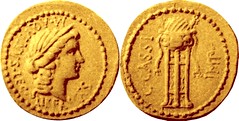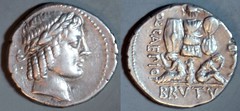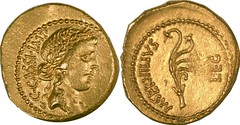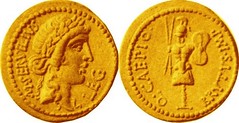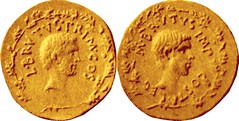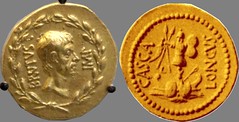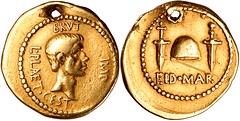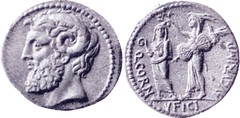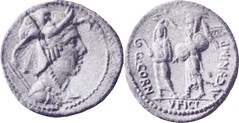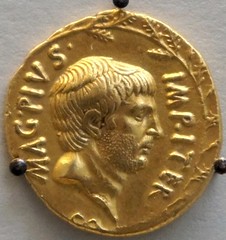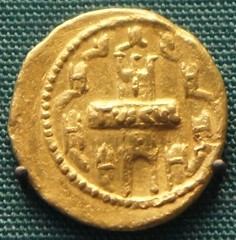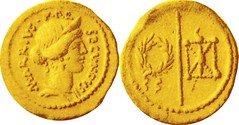Part 18 RRC 498 to RRC 515, 43BC to 42BC, Brutus, Cassius, Octavian, Antony, Sextus Pompey.

|
Specialist Supplements:
1. Roman Coins of Luceria and Canusium
2. Anonymous Struck Bronze Coins of the Roman Republic
3. Anonymous Roman Republican Denarii and Victoriati (Steve Brinkman's site)
Principal Coins of the Roman Republic
Part 18 RRC 498 to RRC 515, 43BC to 42BC, Brutus, Cassius, Octavian, Antony, Sextus Pompey.
RRC 498 C.CASSI, M.AQVINI, Cassius, Aquinia 43BC to 42BC, moving with Cassius aureus
RRC 500/1/3/5 C.CASSI, LENTVLVS SPINT, Cassius, Cornelia 43BC to 42BC, moving with Brutus and Cassius denarii.
RRC 500/7 C.CASSI, LENTVLVS SPINT, Cassius, Cornelia 43BC to 42BC, moving with Brutus and Cassius denarius.
RRC 501 CAEPIO, BRVTVS, Brutus 43BC to 42BC, moving with Brutus denarius
RRC 502 Q.CAEPIO BRVTVS, L.SESTI, Brutus, Sestia 43BC to 42BC, moving with Brutus denarius, quinarius.
RRC 503 Q.CAEPIO BRVTVS, Brutus 43BC to 42BC, moving with Brutus denarius. Davis coll.
RRC 504 C.FLAV.HEMIC, Q.CAEP.BRVT, Brutus, Flavia, 43BC to 42BC, moving with Brutus denarius
RRC 505 C.CASSEI M.SERVILIVS Cassius, Servilia 43BC to 42BC, moving with Brutus and Cassius denarius
RRC 506 BRVTVS, COSTA LEG, Brutus, Pedania moving with Brutus denarius, quinarius.
RRC 505/1/4 C.CASSEI M.SERVILIVS Cassius, Servilia 43BC to 42BC, moving with Brutus and Cassius aurei.
RRC 506 BRVTVS, COSTA LEG, Brutus, Pedania 43BC to 42BC, moving with Brutus aureus.
This is the only coin showing Brutus' birth name, M(arcus Junius) Brutus, rather than his adoptive
name Quintus Caepio Brutus. Of course it also shows his portrait, one of several Brutus coins to do so,
odd in view of his stance against the regal trappings of Julius Caesar. The other Brutus on the coin
is Lucius Brutus, the first Consul of Rome as his title states.
RRC 507 BRVTVS, CASCA LONGVS, Brutus, Servilia 43BC to 42BC, moving with Brutus denarius.
RRC 508 BRVT, L.PLAET.CEST, Brutus, Plaetoria 43BC to 42BC, moving with Brutus denarius.
Medici Medal after RRC 508 about 1550AD, Venice Rennaissance medal.
Venetian school attributed to Gavino. The type copies Crawford 508/3.
It commemorates the assassination of Alessandro de Medici on 6th January 1537 by the killer's cousin Lorenzino who is portrayed.
The reverse shows a cap of liberty between two daggers, VIII.ID.IAN below, or ante diem VIII Id.Ian. which
translates to 6th January. Cessi 53. Toderi Vannel Medaglie 743. Attwood 891. Calvera 19 (not this copy).
This is an original 16th century copy, cast in bronze bell metal. On January 6, 1537,
prompted by Filippo Strozzi, Lorenzino de Medici and the killer Scoronconcolo murdered his cousin,
Duke Alessandro de Medici. Lorenzino entrapped Alessandro through the ruse of a promised arranged sexual encounter
with Lorenzino's sister Laudomia, a beautiful widow.
After this, he fled to Bologna, and from there to Turkey, France, and then Venice.
He wrote a public defense of his actions (the Apologia), claiming that, as an ideal heir of Marcus Junius Brutus,
dedication to human liberty had forced him to kill Alessandro.
Cosimo I de' Medici became Duke of Florence, and condemned Lorenzino to death.
An assassin in Cosimo's pay killed Lorenzino in 1548 in front of his lover's house at Campo San Polo, Venice.
The medal was made by his supporters.
and just as with Brutus the type wishes to sing the
praises of a tyrranicide. Herbert Cahn noted this actual medal as evidence that
the EID MAR denarius type has been prized by collectors and
scholars since the Renaissance, but it was also celebrated in ancient times as well.
Dio Cassius mentioned it in the 3rd century, and its reverse was copied on a denarius issued during the Civil Wars
of 68-69 (RIC 24-25).
RRC 509 Q.CORNVFICI Cornuficius 42BC, Africa denarius.
Quintus Cornuficius was the republican governor of Africa Vetus (the "old" province) from 44-42 BC, during the
civil wars. He was a man of considerable refinement, a poet and orator and a close friend of Cicero and Catullus.
In 43 BC, Cornuficius refused to hand over his province to Antony's nominee, and he was proscribed by the triumviral
government. In 42 BC, he was attacked by Titus Sextius, the governor of the neighboring province of Africa Nova.
The course of this local conflict mirrored that of the wider civil war. Cornuficius enjoyed some initial success,
even briefly invading Sextius' province, but he was utimately defeated and killed outside Utica in 42 BC. Before
his defeat, Cornuficius produced a remarkable coinage in gold and silver, of astonishing artistic achievement.
The three obverse types, heads of Africa, Jupiter Ammon, and Ceres-Tanit, all refer to his province of Africa.
They share a common reverse, which depicts Cornuficius as augur being crowned by Juno Sospita, seemingly a
reference to his own Lanuvine origin. All of these coins are of considerable rarity today.
In Tresors Monetaires XX, 2002, p. 1-4, Michel Amandry published a definitive die study and corpus of this
fascinating issue. Amandry knew of only 24 denarii of all types, including 12 with the head of Ceres-Tanit.
These latter were struck from only three obverse and six reverse dies; three of these reverses were also paired
with the Jupiter Ammon obverse.
Phil Davis is aware of two additional specimens of Ceres-Tanit; thus, this coin is perhaps the fifteenth known example.
Following Crawford, the "conventional wisdom" is that all plated Republican silver coins are contemporary
forgeries. The coins of Cornuficius seem to present an unmistakable exception to this general rule.
Three coins in Amandy's Corpus are also fourrees; thus, including the present coin, out of 15 known examples,
four are plated. This is an almost inconceivable percentage, if these fourrees are indeed ancient forgeries.
They are struck from two obverse and two reverse dies; thus the hypothetical forger would have needed to possess
by happenstance at least two examples of this exceedingly rare coin. There is good reason however to believe that
in this particular case the plated coins are just as "official" as the good silver ones, especially as the plated
and good silver coins share dies. It is possible to construct a persuasive scenario for this claim which doesn't
violate Crawford's general dictum. The good silver coins would be the money Quintus Cornuficius minted to pay his
soldiers, in the early, successful days of his struggle for North Africa. As the war turned against him, it is
easy to imagine him increasingly strapped for precious metal, and resorting to striking more and more plated
denarii. His soldiers expected to be paid, and were probably prepared not to examine that payment overly closely.
At the end, he was restricted to Utica and its environs; how much silver could have remained there after months of
fighting. [notes by Phil Davis and Harlan J.Berk]
RRC 507 BRVTVS, CASCA LONGVS, Brutus, Servilia 43BC to 42BC, moving with Brutus aureus.
RRC 508 BRVT. L.PLAET.CEST., Brutus, Plaetoria 43BC to 42BC, moving with Brutus denarius, aureus.
A trio of Brutus portraits. This EID MAR aureus is mentioned in RRC p.552 as false, however this was on the
basis of viewing a cast of the piece in the ANS labelled "forgery, Athens". Having since viewed the piece in hand
Crawford accepts it as genuine. It was documented by Herbert Cahn in the 1953 Numismatic Congress proceedings, p.215.
The piece was in the Biaggi collection until the 1970s, resurfaced in NAC27, 2004 and was added to the Winckless
collection. Michael Winckless put it on long term loan to the British Museum where it is on display in the
Roman galleries. As an old provenance piece - the plaster casts in the ANS and BM date from the 1930s - its
acquisition was welcomed by the BM. The photo is courtesy the Trustees of the British Museum, with permission.
The EID MAR denarius actually combines obverse of BM 508.3.4 and the reverse
of BM 508.3.3. BM 508.3.3 is ex Thomas Herbert, 8th Earl of Pembroke collection.
Herbert was First Lord of the Admiralty and Lord High Admiral 1690-1692 and was Lord Privy Seal 1692 to 1699.
In 1689 to 1690 he was President of the Royal Society (1689-1690). He was a famous collector; his coin collection
was published in 1746, and the BM bought this coin when it was dispersed by Sotheby's in 1848. BM 508.3.4
was bequeathed by Dr. Laurie Lawrence in 1950. Lawrence was Honorary Assistant Keeper in the
Department of Coins and Medals, and he gave many coins to the BM.
The two coins were photographed whilst on public display, side by side,
in a special exhibition late 2012, thus allowing me to snap a picture with my own copyright. It is a rare
chance to see enlarged photos of old provenance EID MAR types; most examples available for viewing today
are newer finds with dubious provenances.
RRC 509/2/4/5 Q.CORNVFICI Cornuficius 42BC, Africa denarii.
RRC 510 MURCVS IMP Murcus 42BC to 41BC moving with L.Staius Murcus denarius
RRC 511 MAG.PIVS CLAS ET ORAE MARIT EX SC Sextus Pompey C:42BC to 40BC, W:37BC to 36BC, Sicily denarii.
Woytek places the RRC 511 types late in Sextus Pompey's time in Sicily, citing
Jane de Rose Evans, "The Sicilian coinage of Sextus Pompeius", ANSMN 1987, and his own article in JNG 1995,
"MAG PIVS IMP ITER". Crawford, citing a Messina hoard published in 1997 that contains Rome mint coins of
44BC and 42BC, coins of Brutus and Cassius, and a 41BC piece of Antony, still prefers an earlier date; this
raises questions of how Sextus Pompey financed operations in the early 30s BC, perhaps with bronze coin.
RRC 511 MAG.PIVS CLAS ET ORAE MARIT EX SC Sextus Pompey C:42BC to 40BC, W:37BC to 36BC, Sicily aureus.
RRC 513 M.ARRIVS SECVNDVS, Arria C:41BC, W:43BC Rome denarius
RRC 515 L.SERVIVS RVFVS, Servia C:41BC, W:43BC Rome aureus.
I generally avoid illustrating one-sided coins but two of these three pieces are of such rarity (the Arria and
the Servia), and the third of such quality that they demand to be shown.
The first and third are from the British Museum public displays, the Arria is from the Capitoline. This Arria type
with soldiers exchanging a standard is very much rarer than the type showing a phalera, spear and wreath. The
city view of the walls of Tusculum, inscribed TVSCVL, on the Servia is an extraordinary architectural device for a
Roman Republican coin although such views were to appear more frequently on later Provincial coinage. I mentioned
in the introduction to
Part 15, RRC 440 to RRC 462 that Crawford and Woytek still maintain a difference
in views regarding the Rome coinage of 41BC and 43BC. Hoard evidence is cited in both Woytek's Arma et Nummi and in
Crawford's discussion in his 2012 review of same; I have an open
mind on the matter. On the one hand the portrait types and other material presented by Woytek
argue for a 43BC date for RRC 512 to RRC 515, and a 41BC date for RRC 485 to RRC 487. On the other hand
Crawford cites the Flores hoard which contains a couple of examples of RRC 485 and RRC 487 but otherwise
predominantly issues of Brutus and Cassius, and of Rome in 44BC and 42BC, which contents probably argue for
a 42BC concealment date. No doubt more material will appear in time, so, this will get resolved one way or the other.
RRC 514 C.NVMONIVS VAALA, Numonia, Julius Caesar C:41BC, W:43BC Rome denarius.
RRC 515 L.SERVIVS RVFVS, Servia, Brutus C:41BC, W:43BC Rome denarius.
I am content that the Ahala Collection does contain this one good portrait coin of Brutus; we can leave
discussions about whether the portrait is lifetime or posthumous for a later date.
RRC 513 M.ARRIVS SECVNDVS, Arria C:41BC, W:43BC Rome aureus.
Specialist Supplements:
1. Roman Coins of Luceria and Canusium
2. Anonymous Struck Bronze Coins of the Roman Republic
3. Anonymous Roman Republican Denarii and Victoriati (Steve Brinkman's site)
All content copyright © 2004-2013 Andrew McCabe unless otherwise noted. If you've any questions or comments please contact me on the Yahoo Group RROME: http://groups.yahoo.com/group/RROME.
Alternately you can leave comments against any coin picture, just click on the picture and write in the comment box.
comment: this page is RRC498.html
Site hosted free courtesy of VCoins.com
Ancient Coins on Vcoins






